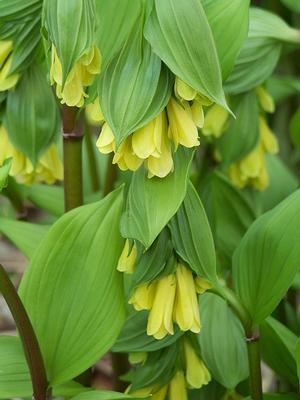Three Distinguished Disporum
Gardeners may know Disporum as Fairy Bells. Their presence with arching stems and alternating simple leaves visually links them to Solomon's Seals (Polygonatum), False Solomon's Seal (Maianthemum or Smilacina) and Merrybells (Uvularia). In familial overview they are all closely related, classified in Colchicaceae, gracing us with spring bloom with all above-ground parts erupting from slowly forging under-the-soil-surface branching rhizomes.
Disporum beckons the gardener in warm spring breezes with large and showy nodding bells at stem tips. Occasionally some species when particularly happy may even branch severally beginning from axils of the main stem half to two-thirds the way up from the ground. Speaking of stems, some species tend to be fairly straight while others zig zag attractively and noticeably from one axil to the next in an architectonic display.
Fairy Bells are shade-lovers gradually extending their reach in a ground covering manner. Early morning sun, very late day sunshine and dappled conditions suit them well. All revel in fertile, moisture-retentive ground. As with many woodland companions they are adapted to drier summer conditions. Once settled they are easy and a great contrasting plant in both form and texture enriching the bounty of the cool, shady realm.
The genus Disporum encompasses approximately twenty species and now many named selections and varieties from various species in the genus. We examine three especially distinguished members among the greater family of aristocratic Fairy Bells.
Our original purchase of Disporum longistylum ‘Night Heron’ (formerly D. cantoniense) came from Dan Hinkley's remarkable Heronswood Nursery near Kingston, Washington. Originating in China this exceptional Fairy Bell distinguishes itself upon emerging from the moment it breaks ground in spring. When the stems first arise from cool soil they support down-turned heads sheathed in still unfurled foliage resembling purple-black silhouettes of a resting flock of elegant herons with crooked necks, their heads nestling into their chests. The leaves, attractively striated with longitudinal leaf veins from petioles to tips become glossy green often infused with some remaining purple during the summer. Stems may potentially grow as tall as six feet in the happiest of conditions but usually miss that stratospheric mark . This species as well as the very closely related D. cantoniense often branches from about half to two-thirds up the stem from the garden floor. Pretty creamy yellow touched with green flowers are not large but contrast nicely to the darker foliage. But for all they lack in size they compensate in number. Round purple-black berry-like fruits follow. This is a tall and somewhat dense growing plant which flouts weeds. Though listed as a USDA zone 6 plant it has been doing well for us on the east side of a short stone wall in much afternoon sun, only growing to about 3’ in northeastern Connecticut. We have expanded its cold tolerance to zone 5b. In another surprise 'Night Heron' tolerates well hot afternoon midsummer sun. 'Night Heron' will spread moderately, slowly colonizing.
Disporum sessile ‘Variegatum’ is a beautiful variegated plant with dark green and white elliptic leaves. Stemless, they clutch stalks. Large, showy white terminal bells are touched with deep green at the tips. Large, dark blue-black berries follow – a beautiful contrast to the white variegated foliage. This lovely woodland perennial moves about, ground covering in open disposition with a tendency to sprout new stems a short distance from where you might have expected. Though I have seen it listed with varying heights ours grow to about 8” tall, hardy in zones 4 to 9 and moderately colonizing. Just Beautiful in foliage, flower and fruit, D. sessile 'Variegatum' comes from Japan.
Robust growing Disporum uniflorum (syn. D. sessile subsp. flavens) flaunts clusters of very showy yellow pendant bells at stem tips in spring soon after they emerge from winter dormancy. The Korean Fairybell is dense growing with stems emerging very close together which slowly increases girth over time. Stems rise from eighteen up to twenty-four inches setting so densely that this exquisite Fairybell bars uninvited, marauding weeds. The handsome deep green leaves are prominently veined, exude an almost vinyl sheen and remain clean through the growing season. Leaves sometimes becoming yellow to golden brown in the autumn before succumbing to dormancy. Black fruits set up towards season's end and are especially pretty when set against autumnal tones. The Korean Fairybell whose nativity is also Manchuria, China is also sometimes listed as D. flavens and even occasionally I have seen it written as D. flavum. But the newer accepted taxonomical ID is currently D. uniflorum. It is hardy perfectly hardy in zone 5, dipping into 4 and extends southward to 8.
Ahh, I can hear the Fairybells ringing in the distance. Dig in. Have fun.
penned by Wayne Paquette, January 2016

Disporum uniflorum
